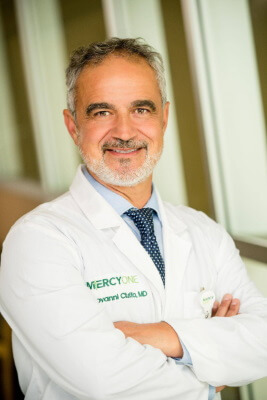Treating aneurysms has come a long way since the early days of surgical medicine. Conditions that would have been fatal several decades ago are now often survivable by procedures that would have been inconceivable at that time. One particular example we will look at here is an Abdominal Aortic Aneurysm (AAA).
When first diagnosed with an Abdominal Aortic Aneurysm, many patients are scared to ask “what is an aneurysm?” It’s a natural hesitation, especially since the condition is often perceived as lethal. Not only does Dr. Ciuffo pride himself of his surgical technique and innovative methods, he also considers a patient’s understanding and clarification of their condition to be of the highest priority. If you’ve been diagnosed with this condition and are struggling to ask questions, take heart: there are health care professionals who care.
What is an Abdominal Aortic Aneurysm?
Simply put, the aorta is the main conduit, or pipeline, in the body. It sends blood flowing to every organ and every part of the body through its side branches. When the aorta expands, or “balloons”, over time to a dangerous size, it becomes essential that it be repaired surgically. Failure to address the issue in time could lead to an aortic dissection, also known as a “blowout”.
What makes this an abdominal issue, as opposed to a heart issue, is the location of the distress in the aorta. The part of the aorta that is closer to the heart – roughly from the solar plexus and higher – is considered the thoracic aorta. The part of the aorta below that area is considered the abdominal aorta. It is considered an Abdominal Aortic Aneurysm when the expanded portion of the aorta is below that point.

How to Treat AAA
The procedure involved in correcting this issue can be compared to simple plumbing. The surgeon goes into the area of the aorta that has expanded to critical size, removes it, and replaces it with an artificial pipe that restores it to regular size and function.
Treating aneurysms is an ever-evolving science, and Dr. Ciuffo’s team is at the forefront of the field.
When Is This Condition Considered to Be Inoperable?
There are several reasons why a doctor using traditional methods may diagnose this condition as untreatable, but here are a few of their most common concerns:
- The patient is too old or frail, or general age or health concerns of a patient’s overall ability to endure and recover from surgery
- The patient’s aorta is heavily calcified, making it difficult to connect to a machine or clamp
- The patient has bad lungs, kidneys, or liver, increasing risk of additional medical issues
- The patient’s heart is too weak, making post-operative recovery more difficult
If you or a loved one has been refused treatment and told your AAA is inoperable, please schedule a consultation with Dr. Ciuffo today to discuss further options that may be available to you. After all, you aren’t giving up on treatment, so why should your doctor?

